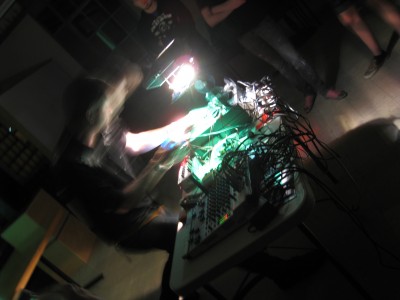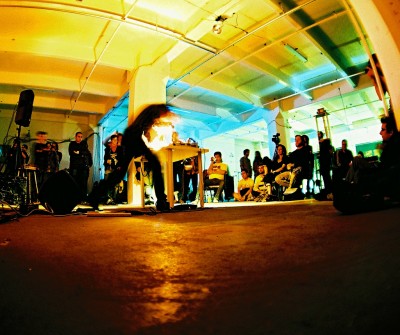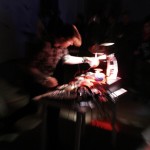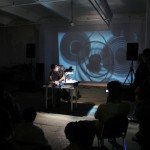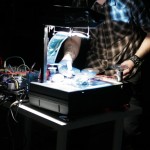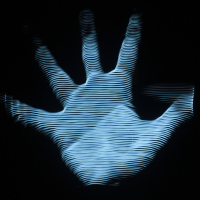
DATES
FRI 16 April: Buffalo NY–SoundLab, 110 Pearl Street: TONEWHEELS performance + Affecting Animate Nerve Organs (16 artist multi-media installation) [8pm]
(UPDATE!!!!) SUN18 April: Syracuse NY–Spark Contemporary Art Space: TONEWHEELS performance + Heavy Hymns [8pm]
TUE 20 April: NYC, NY–Electronic Music Foundation, 307 7th avenue ste 1402: “A Brief History of Optical Synthesis” lecture [7pm]
WED 21 April-THU 22 April: NYC, NY–Harvestworks: Soundtransit-The Art of Field Recording workshop [6:30pm each night] SOLD OUT!!!
FRI 23 April: NYC, NY–Bent Festival, Dumbo, 81 Front Street: TONEWHEELS workshop [12pm] performance [8pm]
TUES 27 April: NYC, NY–Electronic Music Foundation, 307 7th avenue ste 1402: Tuned City lecture [7pm]
THU 29 April: Providence, RI–Rhode Island School of Design: TONEWHEELS workshop
FRI 30 April: Providence, RI-AS220: TONEWHEELS performance + Black Pus (1/2 Lightning Bolt), Humanbeast and Shawn Greenlee [9pm]
(UPDATE!!! NEW LOCATION!!!) SAT 1 May: Cambridge, MA: Existence Establishment @ MIT Building N52, 265 Massachusetts Ave: TONEWHEELS performance + Karlheinz, Shawn Greenlee, Animal Steel, Brandon Terzakis, Benjamin Nelson, Bombings [8pm]
FLIERS


DETAILS
TONEWHEELS PERFORMANCE
TONEWHEELS is an experiment in converting graphical imagery to sound, inspired by some of the pioneering 20th Century electronic music inventions. Transparent tonewheels with repeating patterns are spun over light-sensitive electronic circuitry to produce sound and light pulsations and textures. This all-analog set is performed entirely live without the use of computers, using only overhead projectors as light source, performance interface and audience display. In this way, TONEWHEELS aims to open up the “black box” of electronic music and video by exposing the working processes of the performance for the audience to see.
TONEWHEELS WORKSHOP
TONEWHEELS is an experiment in converting graphical imagery to sound, inspired by some of the pioneering 20th Century electronic music inventions such as the ANS Synthesizer (Murzin USSR 1937-57), the Variophone (Sholpo USSR 1930) and the Oramics system (Oram UK 1957). In this workshop, participants will learn to construct their own optoelectronic synthesizer using two different circuits: a simple light-to-sound converter and a variable motor speed controller, as well as how to design and print their own tonewheel patterns using the FLOSS software Inkscape.
“A BRIEF HISTORY OF OPTICAL SYNTHESIS”
The technology of synthesizing sound from light is a curious combination of research from the realms of mathematics, physics, electronics and communications theory which found realization in the industries of motion picture films, electronic music, surveillance technology and finally digital communications.
This lecture will touch on various points in the development of optical sound synthesis in these various contexts, referencing the work of Joseph Fourier, Hermann von Helmholtz, Rudolph Koenig, Arseny Avraamov, Thomas Wilfred, Evgeny Scholpo, Nikolai Voinov, Oskar Fischinger, Boris Yankovsky, Edwin Emil Welte, Evgeny Murzin, Norman McLaren, Lev Theremin, Daphne Oram, Jacques Dudon and Iannis Xenakis, among others.
This lecture is given in the context of the opto-electronic performance TONEWHEELS, by Derek Holzer at the Bent Festival the following Friday.
Soundtransit-The Art of Field Recording
Wednesday & Thursday, April 21 & 22 6:30 – 9:30pm $100
Field recording, or phonography, is the art of recording sounds as they are found “in situ”, rather than those created in a studio or concert hall. There are as many ways of approaching field recording as there are field recordists, with interests ranging from recordings of natural or urban environments to improvised situations or soundwalks to the resonance of solid objects or the Earth’s atmosphere.
The first session of this workshop provides a theoretical introduction to the various microphone techniques and recording strategies used for field recording, as well as special tools which allow phenomenon such as physical motion, electromagnetic waves and light can also be converted into sound. This will be followed by a night-time recording excursion into the city.
The second session consists of a critical listening session of the sounds gathered the night before. Key concepts to be explored include musical and cinematic metaphors of sound, composing the cityscape and communicating senses of place and space through sound.
Participants may wish to upload their finished recordings to the Soundtransit.nl website, where they can be used to plan sonic journeys between hundreds of locations around the world.
While the instructor can provide one shared recorder and microphone, participants should bring their own recording equipment when possible. Derek Holzer can provide a simple pair of binaural microphones for sale at a cost of approx $35. They terminate in a right-angle stereo minijack plug, and use the plugin power from the stereo microphone input of the recorder. Please indicate before the workshop date if you would like to buy a pair, and please check that your recorder provides this plugin power (most with minijack stereo mic inputs do) before requesting them.
“Tuned City – Between sound and space speculation”
“Tuned City – Between sound and space speculation” was an exhibition and conference project taking place from July 01.-05. 2008 in Berlin which proposed a new evaluation of architectural spaces from the perspective of the acoustic. It’s next edition is scheduled to take place during the Cultural Capital summer of 2011 in Tallinn, Estonia.
In this lecture, we will see and hear some of the projects from the Tuned City event by Mark Bain, Raviv Ganchrow, Will Schrimshaw, John Grzinich, James Beckett, Akio Suzuki, Barry Blesser, Randy H.Y. Yau + Scott Arford, Thomas Ankersmit + Antoine Chessex, Bernhard Leitner, CRESSON, Farmers Manual, AGF, Chris Watson + BJ Nilsen, Jacob Kirkegaard, Martin Howse, Ralf Schreiber + Martin Kuentz and Staalplaat Sound System will be discussed, among others, as well as related projects covering the themes of Temporary Architecture for Sound, Buildings as Instruments and Composing the Cityscape. A limited number of catalogs and program guides will also be available.
Thanks!
Huge thanks go to Alexis Bhagat of ((audience)) and Shawn Greenlee of RISD for their monumental efforts to get this thing off the ground! Thanks also to Brendan Byrne of Bent, Joel Chadabe of EMF, Hans Tammen of Harvestworks, Egan Budd of Existence Establishment, Natalia Mount of Red House, Michael Baumann of Soundlab and Sean Donaher of CEPA for actually booking me, and to Gill Arno, Raphael Lyon and Tristan Perich for putting up crash space in NYC.
Now Playing
Carl Gustav Jung–Dreams[book 1910-1952]
Pierre Klossowski–Roberte Ce Soir & The Revocation of the Edict of Nantes[book 1953]













